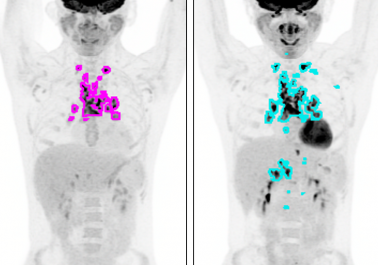Deploying New Imaging Techniques for HIV
By Jeffrey Laurence, M.D.
Published Friday, October 11, 2019
Research Question
 PET scan Image: NIAIDA major impediment to an HIV cure is persistence of cells latently infected with virus despite the use of potent anti-HIV therapies. There are multiple mechanisms by which such latent viral reservoirs might be maintained across anatomical sites, from the brain to the gut—tissues that are somewhat inaccessible to anti-HIV medications.
PET scan Image: NIAIDA major impediment to an HIV cure is persistence of cells latently infected with virus despite the use of potent anti-HIV therapies. There are multiple mechanisms by which such latent viral reservoirs might be maintained across anatomical sites, from the brain to the gut—tissues that are somewhat inaccessible to anti-HIV medications.
So how can we define these mechanisms and chart the impact of experimental therapies on HIV reservoirs that are difficult to access for routine sampling? Non-invasive in vivo methods are urgently needed to address these fundamental gaps in our knowledge.
Findings and Impact
Dr. Timothy Henrich and colleagues from the University of California, San Francisco, reviewed a “toolbox” of nuclear imaging approaches—technology that has demonstrated success in assessing the spread of cancers—to directly visualize HIV and its impact on inflammation and metabolism throughout the body.
These approaches include high-sensitivity PET scans and radioactive tracers to identify HIV and the presence of specific anti-HIV drugs. Recent advances in these techniques could give scientists the ability to tailor the best anti-HIV drug combination to an individual, to identify HIV reservoirs based on non-viral attributes, and to monitor individualized responses to various therapeutic interventions.
The authors note that these emerging technologies “may play an important role in the development of novel therapeutic and HIV reservoir eradication strategies.”
amfAR’s Role
Researchers involved with this study are affiliated with the amfAR Institute for HIV Cure Research.
Original Article
http://www.ncbi.nlm.nih.gov/pubmed/31572355
Dr. Laurence is amfAR’s senior scientific consultant.